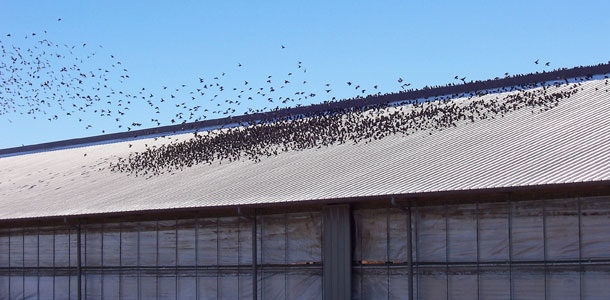Some people may find bird watching to be an enjoyable hobby, but for a dairy producer, watching flocks of birds attack feed piles or roost in barn rafters is not their idea of a good time.
In fact, birds – specifically, starlings – can be quite destructive on dairies, causing feed and property damage and posing a serious risk to both human and animal health. As the fall season sets in, now is the time to discourage birds from flocking to your dairy.
Why are birds a problem?
When temperatures drop, bird species like the European starling seek a reliable food source and an environment that protects them from the elements. An open feed pile and a freestall barn often offer both, making dairies an ideal place for birds to congregate.
Starlings are not merely a nuisance; they can cause deadly damage. Cattle feeding and watering areas can become contaminated with bird droppings, according to Chad Heuser, who works with USDA-APHIS, Wildlife Services (WS) in eastern Washington. When cattle consume feed or drink water exposed to droppings, they are at risk for salmonella and E. coli infections. That risk carries over to farm workers who come in contact with bird feces. Histoplasmosis is another illness that people may contract from inhaling fungus spores from decomposing droppings.
Dairy cows also suffer when birds pick out the energy-dense particles from feed. “We do know it reduces milk production because cattle aren’t getting the nutrients they need when the birds are present,” Charles Lovell adds, speaking from his experience as a certified wildlife biologist and district supervisor for USDA-APHIS WS in Wisconsin.
Those little beak-fulls of feed add up. According to the USDA-APHIS WS, a flock of 1,000 starlings can consume up to 40 pounds of feed per day. Considering a typical dairy cow consumes around 100 pounds of feed daily, that is the equivalent of feeding 2.5 cows. Heuser and Lovell have both seen severe starling situations on dairies with bird numbers in the several thousands, resulting in costly feed losses.
What can you do about it?
Heuser tells dairy producers to keep three things in mind when it comes to controlling starlings and other birds: “patience, persistence and time.” This applies to both non-lethal and lethal bird removal tactics.
Non-lethal methods
Prevent entrance into buildings.
When possible, keeping doors closed bars birds from entering. For barns with an open-ridge roof, applying netting can keep birds out while not disturbing natural ventilation.
Cover feed piles
Heuser recommends covering open feed piles with a tarp to detract birds, while leaving one end open from which to feed.
Eliminate roosting areas
Barn rafters can be an attractive place for birds to roost. Discourage this by attaching a two-by-four board at least at a 45-degree angle to eliminate birds from sitting on the beams.
Make birds uncomfortable
The presence of humans is often enough to discourage bird behavior. Driving alleys and making noise in the barn on a regular basis can disturb the birds’ environment enough for them to leave. Scare devices that play a distress call may do the trick, too.
Pyrotechnics
Low-grade firecrackers can be used to control bird behavior, though some dairy producers seek alternative methods for fear that loud noises will also scare cows. Commonly referred to as bangers or screamers, these devices are most effective when used to interrupt the birds’ daily pattern of leaving their roost to come onto a dairy to feed. Heuser suggests getting ahead by starting this practice early on in the fall in order to break their feeding routine.
Lethal methods
According to Heuser, European starlings are not a native species to the U.S., therefore, they are not protected by any current federal or state protection and no special permit is required for their removal.
State wildlife service agencies offer programs for lethal baiting and removal. A pesticide called DRC-1339 has proven to safely, effectively and almost immediately reduce starling populations. After consuming bait, birds die within 12 to 72 hours. The pesticide is quickly metabolized in the bird’s body, which minimizes potential for secondary poisoning. In order for this practice to be most effective, Heuser recommends dairy producers pre-bait birds by setting out weighed amounts of feed over the course of one week. By gauging the amount of feed consumed, agency staff can estimate the number of birds and how much DRC-1339 will be needed to effectively deal with the problem.
For more information on controlling starlings and other birds on dairies, contact USDA-APHIS WS by calling 1-866-4USDA-WS (1-866-487-3297) to connect with a state office. PD
PHOTO
Photo provided by the USDA.
Read a related article: "What one dairyman is doing to control winged 'thieves.'"










